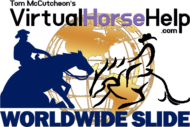If you have ever watched a reining run, in person or on video, you have undoubtedly taken note of the various whistles, hoots and hollers, shouts, and catcalls that accompany each maneuver. (If you have shown yourself, you are likely familiar with these but too focused to ever notice them while riding.) Below are different types of spectators you may encounter at a reining show.
The Coyote Pack. These spectators generally travel in packs and show their approval through a series of yelps and howls. They may space themselves out around the arena to ensure that they can be heard from all sides. Often, cheering is choreographed such that each person picks up where another left off so that the noise is constant during the run.
The First-Timer. This spectator will consistently cheer on the second spin or when an exhibitor goes off-pattern or receives a low score—not out of any sense of malice, but because they don’t know any better. To them, that entire circle off-lead looked just like all the other circles they’ve seen that day, and the second spin is as good a time to cheer as any. Eventually they will get the hang of it all, but for now they are endearingly clueless.
The Overexcited Shouter. This person has a loud voice and cheers for your wobbly -1/2 stop and rollback like it was a +1 ½ maneuver. Shrill, drawn-out “whoo-hoo”s are common, as are triumphant “YEAH”s.
The Trainer. Often, trainers are indistinguishable by their cheers, but some (especially at smaller shows and in lower levels) like to talk riders through their patterns. They will say things like “Fix it!” and “Sit deep!” At some point in everyone’s riding career, their trainer’s dialogue becomes so ingrained that they can hear it in their head without their trainer having to say a word, but until then it is sometimes necessary to coach through patterns.
The Potty Mouth. This person will be very invested in the outcome of the run, and will sit nervously outside of the arena. They may be too nervous to properly cheer, but if something goes wrong they always let slip a swear word or three much louder than intended.
The Whistler. People who dislike cheering often take up whistling instead. In time, dedicated whistlers will master all different types of whistles and will be loud enough to temporarily deafen anyone sitting nearby.
The Multitasker. This person is someone who likes to keep an eye on the show pen while going about their other activities. They make a point to cheer for everyone and can juggle eating lunch, grooming one horse and tacking another, handling their child’s meltdown, and throwing in a cheer here and there for other competitors.
The Quiet Cheerer. These spectators have all the enthusiasm of the Overexcited Shouter and the dedication of the Coyote Pack, but a much smaller volume dial. The rider will probably never hear their whispery cheers, but it’s the thought that counts. This person may be predisposed to quietness, or they may still be adjusting to the relative rowdiness of reining show cheers compared to other disciplines. Clapping is a staple in this person’s repertoire of cheers because it provides an opportunity to be louder without straining one’s voice.
 Virtual Horse Help and Worldwide Slide Horse Training Videos, Show Coverage, Features, Behind-the-Scenes & Bi-Weekly E-Neewsletters
Virtual Horse Help and Worldwide Slide Horse Training Videos, Show Coverage, Features, Behind-the-Scenes & Bi-Weekly E-Neewsletters










